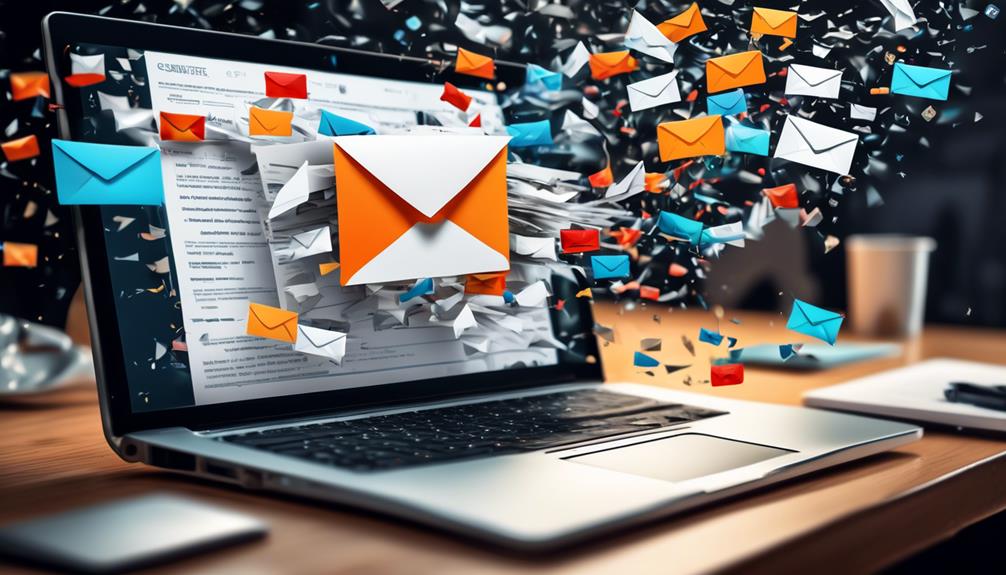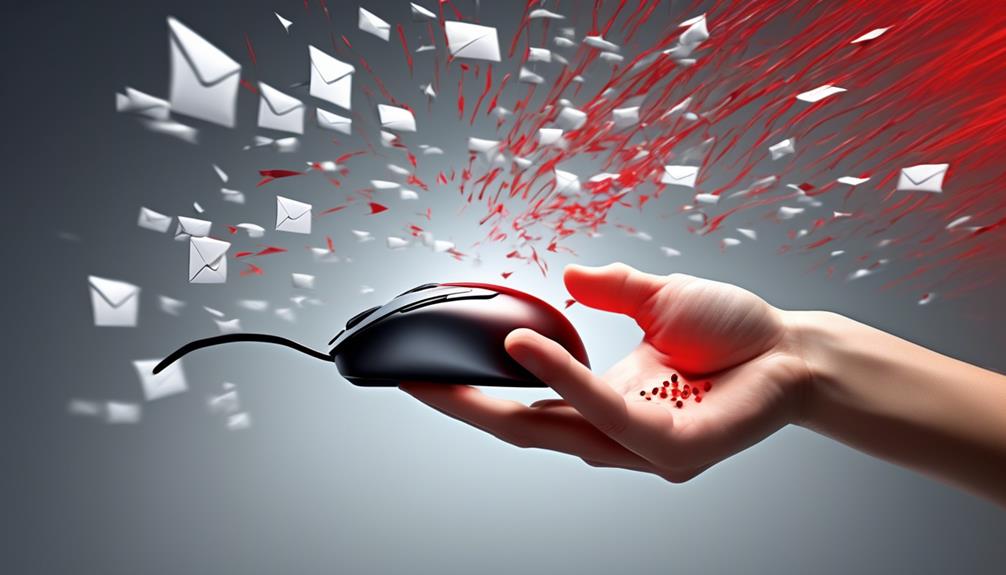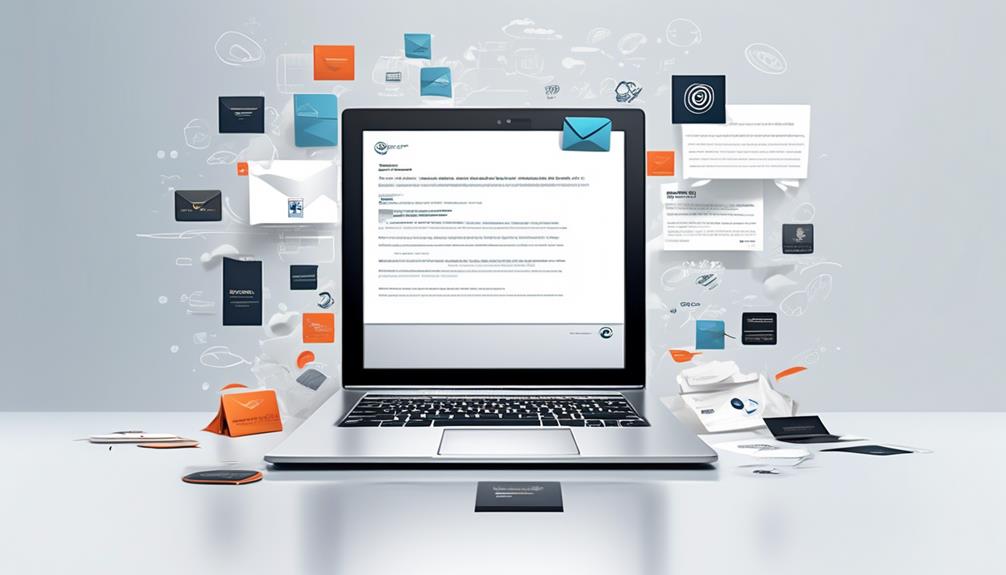We’ve all experienced it – our inboxes overflowing with promotional emails that compete for our attention and clog up our email space.
But how do we put a stop to this incessant digital bombardment?
Unsubscribing from marketing emails is a simple process, but there are some nuances that can make it more effective.
By following a few straightforward steps, we can regain control over our inboxes and reclaim our time.
So, how exactly can we put an end to the deluge of marketing emails?
Key Takeaways
- Email unsubscribe services may not effectively remove you from mailing lists and may simply move unwanted emails to subfolders or the trash bin.
- Exercise caution with third-party unsubscribe services that may require payment or access to personal data.
- Consider utilizing email rules or filters, manually clicking unsubscribe links, or pausing email delivery to manage and unsubscribe from marketing emails.
- If there is no unsubscribe link, send a direct request to unsubscribe, visit the sender’s website, create email filters, or use third-party tools to remove unwanted emails.
Understanding Email Unsubscribe Services
Understanding email unsubscribe services can be challenging due to their limitations and potential privacy concerns. Email unsubscribe services are designed to clean up unwanted spam messages from your inbox. However, these services may not effectively unsubscribe you from most mailing lists, leading to minimal reduction in unwanted emails. Instead of unsubscribing, these services often move unwanted emails to subfolders or the trash bin, which doesn’t solve the root problem.
Additionally, some unsubscribe tools may request payment or personal data and the results might be delayed, taking days or weeks to see any improvement in your inbox. It’s crucial to approach these services with caution as they require access to personal information and may pose privacy and security risks.
In light of these limitations, users may want to consider managing their inbox independently and implementing techniques to block unwanted emails, thus regaining control over their email privacy and security.
Effective Unsubscribing Techniques

We can easily remove our email from unwanted mailing lists in Gmail, Outlook, iOS Mail, and Edison Mail by using the unsubscribe link provided at the top of promotional emails. Here are some effective unsubscribing techniques to manage unwanted emails and keep your inbox clutter-free:
- Utilize Email Rules or Filters: Set up rules or filters within your email account to automatically sort and manage incoming emails. This can help in organizing your inbox and identifying unwanted emails for easy removal.
- Manually Click Unsubscribe Links: Take the time to manually click the unsubscribe links in promotional emails. This direct action can swiftly remove your email from the sender’s mailing list.
- Pause Email Delivery: If you find yourself overwhelmed with unwanted emails, consider pausing email delivery for a specific sender or promotional emails in general. This can provide temporary relief while you manage your inbox.
- Exercise Caution with Third-Party Unsubscribe Services: Be wary of third-party unsubscribe services that may require payment or access to personal data. Consider the risks and limited effectiveness before utilizing such services to manage unwanted emails.
Managing Unwanted Emails on Different Platforms
When tackling the task of managing unwanted emails on different platforms, it’s essential to efficiently utilize the available features to declutter our inboxes and maintain a streamlined email experience. Most popular email providers offer built-in options for unsubscribing and blocking unwanted emails. Here’s a breakdown of how to manage unwanted emails on different platforms:
| Email Provider | Unsubscribe Option |
|---|---|
| Google Gmail | Find the unsubscribe link at the top of promotional emails, and use the ‘Report spam’ option to prevent similar emails from reaching your inbox. |
| Microsoft Outlook | Look for the unsubscribe link at the top of marketing emails, and manage your subscriptions in the Outlook settings. |
| Apple’s iOS Mail App | Tap the unsubscribe link in some promotional emails, and use the ‘Report Junk’ option to prevent similar emails from appearing. Manage subscriptions in the Mail app settings. |
| Edison Mail | Click the unsubscribe link in promotional emails, and manage your subscriptions in the app settings. |
In addition to these built-in options, consider using third-party unsubscribe services like Clean Email to centrally manage and unsubscribe from various mailing lists across different email providers. By leveraging these tools and features, we can effectively declutter our inboxes and streamline our email experience.
Unsubscribing Without an Unsubscribe Link

To unsubscribe from marketing emails that don’t provide an unsubscribe link, there are several steps you can take:
- Send a Direct Request: Look for the sender’s contact email in the marketing email and send a request to unsubscribe directly to the sender’s email address.
- Visit Sender’s Website: Search the sender’s website for a contact or support page and submit an unsubscribe request through their provided channels.
- Create Email Filters: Use an email client to create a filter that automatically deletes or archives emails from the sender, effectively achieving an unsubscribe action.
- Utilize Third-Party Tools: Utilize third-party email management tools that offer unsubscribe features to help streamline the process of managing and removing unwanted emails from various senders.
The Benefits of Using Clean Email
Using Clean Email enables users to efficiently manage their inbox, improving productivity and reducing the time spent on email organization. By leveraging artificial intelligence, Clean Email helps users achieve inbox zero by intelligently categorizing and prioritizing emails. This allows us to focus on essential messages and avoid the distractions of marketing emails and spam.
With the ability to easily unsubscribe at the top of newsletters and mailing lists, we regain control over our inbox and avoid clutter. Clean Email also provides a block option, preventing unwanted senders from filling our inbox with irrelevant content. This not only saves time but also ensures that important emails aren’t buried in a sea of marketing messages.
The benefits of using Clean Email extend beyond time-saving and productivity improvements. It allows us to free up storage space in our mailbox and avoid missing crucial communications. Ultimately, Clean Email streamlines our email management process, allowing us to stay organized and focused, while also providing excellent customer service and support.
Frequently Asked Questions
How Do I Unsubscribe From All Email Marketing?
We can manage all email marketing subscriptions by using the unsubscribe links provided in promotional emails. These links, found at the top of the email, allow us to remove our email from the sender’s mailing list.
Additionally, third-party services like Unroll.me, Clean Email, and Leave Me Alone offer centralized management of subscriptions across different email providers. These tools help us efficiently unsubscribe from various mailing lists.
How Do I Stop Unwanted Marketing Emails?
To stop unwanted marketing emails, we utilize various methods:
- Clicking the unsubscribe link in the email.
- Utilizing email platforms like Gmail or Outlook for easy unsubscribe options.
- Setting up email rules/filters to automatically redirect unwanted emails to subfolders.
In addition, being cautious with providing our email reduces unnecessary subscriptions.
Lastly, regularly reviewing and managing email subscriptions keeps our inbox organized and free from unwanted marketing emails.
What Is the Easiest Way to Unsubscribe From Emails?
The easiest way to unsubscribe from emails is by using the provided unsubscribe link at the top of the email. This allows us to automatically remove our email from the sender’s mailing list.
Additionally, we can consider using third-party unsubscribe services like Unroll.me, Clean Email, or Leave Me Alone for efficient management of various mailing lists across different email providers.
These methods provide quick and effective ways to declutter our inbox.
How Do I Remove an Email From My Marketing List?
To remove an email from our marketing list, we navigate to the email settings or use the unsubscribe link in the marketing email.
We need to be cautious when sharing our email to avoid unnecessary subscriptions. Regularly reviewing and managing our email subscriptions ensures we only receive relevant emails.
Third-party services like Unroll.me, Clean Email, and Leave Me Alone can also help efficiently unsubscribe from various mailing lists and keep our inbox organized.
Conclusion
So, next time you’re drowning in marketing emails, remember that unsubscribing is like cleaning out your closet. Just like getting rid of old clothes, unsubscribing from unwanted emails helps declutter your inbox and makes it easier to find the emails that actually matter.
So, take a few minutes to unsubscribe and enjoy a cleaner, more organized email experience.









